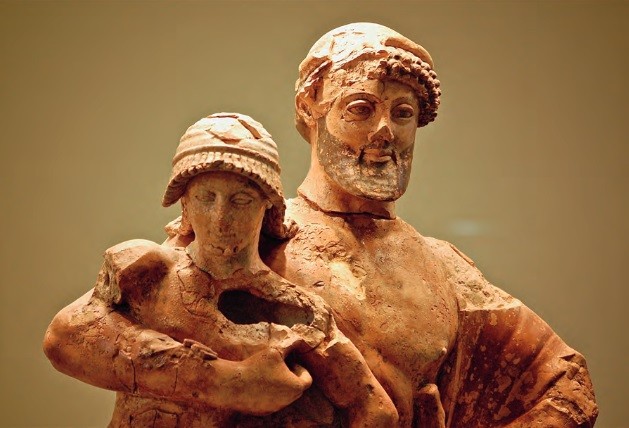I examine how something so integral to
Color in the ancient Mediterranean world was thought to inhere in materials, so that form remained inseparable from color. I argue that colored materials, such as the terracotta and pigments of the Zeus and Ganymede from Olympia, give sculptures a portion of their
I explore philosophical investigations into color and vision by the early atomists, Plato and Aristotle, who theorize colors and visual apprehension as produced through the recombination of atoms. Artists produced complex inlaid eyes, such as those on bronzes from the Riace Marina, not for verisimilitude, but as a means of representing visual processes. In these eyes the interstices are as important as the pieces between which they lie, acting as pores through which colors (as atoms) of the visible world may enter the body. These sculptural bodies show their beholders how the act of beholding unfolds.
I then turn to the beholding body in space. Using the examples of the Ishtar Gate complex at Babylon and the Siphnian Treasury at Delphi, I argue that the use of color on sculptural relief could be an explicit means of destabilizing distinctions between nature and architecture. Through this destabilization, artists returned the built and natural environments to alignment, emphasizing the earth-born sources of the materials used for manmade structures.
Finally, I examine the juxtaposition of colored stones in mosaic, an artistic practice that makes manifest the fragmented mechanics of vision. It is perhaps the explicitness of mosaic that has led to its devaluation in later hierarchies of artistic media, for an image laid out in tesserae mirrors the beholder’s own fragmented nature. In beholding mosaics, one comes to know, not just the particular image, but an image of the assembled matter of the visible world. In matter, vision, and space, colors—as atoms, strokes, or colored stones—mark the pieced-togetherness of being.
Members' Research Report Archive
Color, Matter, Vision, and Space: Approaches to Ancient Mediterranean Polychromy
Jennifer M. S. Stager [University of California, Berkeley]
Paul Mellon Fellow, 2009–2012
The polychromy of ancient Mediterranean art is an issue with which scholars have grappled for centuries. The fugitive nature of many pigments, coupled with the neoclassical taste for the stripped antique fragment, has contributed to a fictional narrative that contradicts the material and textual records, a narrative of art and culture executed in halftones. In my dissertation, “The Embodiment of Color in Ancient Mediterranean Art,” I argue that color is a material phenomenon that forms bodies, structures vision, and shapes a beholder’s experience of the built and natural environments. In presenting this argument, I pursue four lines of inquiry: the role of replication in separating color and form; the material significance of color in the formation of sculpture; the relationship of inlaid eyes to ancient Greek theories of vision; and the use of color on relief sculpture. In each of these chapters I situate Greek artistic practice within the context of the wider Mediterranean world, for which ancient use of polychromy has always been a less controversial topic. I focus on the abundance of color still present in the material record, as well as recent discoveries in conservation, to demonstrate that color was not, as is often argued, applied in the pursuit of lifelikeness, but served as a vehicle for philosophical and aesthetic investigations of bodily experience. I argue for the active role of material polychromy in structuring ancient Mediterranean conceptions of figural and living bodies.

Zeus and Ganymede, c. 470 BCE. Olympia Museum. Author photograph